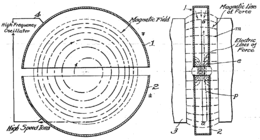Two-dimensional gas
A two-dimensional gas is a collection of objects constrained to move in a planar or other two-dimensional space in a gaseous state. The objects can be: ideal gas elements such as rigid disks undergoing elastic collisions; elementary particles, or any object in physics which obeys laws of motion. The concept of a two-dimensional gas is used either because:
- (a) the issue being studied actually takes place in two dimensions (as certain surface molecular phenomena); or,
- (b) the two-dimensional form of the problem is more tractable than the analogous mathematically more complex three-dimensional problem.
While physicists have studied simple two body interactions on a plane for centuries, the attention given to the two-dimensional gas (having many bodies in motion) is a 20th-century pursuit. Applications have led to better understanding of superconductivity,[1] gas thermodynamics, certain solid state problems and several questions in quantum mechanics.
Classical mechanics

Research at Princeton University in the early 1960s[2] posed the question of whether the Maxwell–Boltzmann statistics and other thermodynamic laws could be derived from Newtonian laws applied to multi-body systems rather than through the conventional methods of statistical mechanics. While this question appears intractable from a three-dimensional closed form solution, the problem behaves differently in two-dimensional space. In particular an ideal two-dimensional gas was examined from the standpoint of relaxation time to equilibrium velocity distribution given several arbitrary initial conditions of the ideal gas. Relaxation times were shown to be very fast: on the order of mean free time .
In 1996 a computational approach was taken to the classical mechanics non-equilibrium problem of heat flow within a two-dimensional gas.[3] This simulation work showed that for N>1500, good agreement with continuous systems is obtained.
Electron gas

While the principle of the cyclotron to create a two-dimensional array of electrons has existed since 1934, the tool was originally not really used to analyze interactions among the electrons (e.g. two-dimensional gas dynamics). An early research investigation to explore a two-dimensional electron gas[4] with respect to cyclotron resonance behavior and the de Haas–van Alphen effect. The investigator was able to demonstrate for a two-dimensional gas, the de Haas–van Alphen oscillation period is independent of the short-range electron interactions.
Later applications to Bose gas
In 1991 a theoretical proof was made that a Bose gas can exist in two dimensions.[5] In the same work an experimental recommendation was made that could verify the hypothesis.
Experimental research with a molecular gas
Stranick used an scanning tunnelling microscope in ultrahigh vacuum (UHV) to image a two dimensional benzene gas layer in contact with a planar solid interface at 77 kelvins.[6] The experimenters were able to observe benzene molecules moving freely as a two-dimensional gas on the surface of Cu(111), to which a planar monomolecular film of solid benzene adhered. Thus the scientists could witness the equilibrium of the gas in contact with its solid state, even by observing transient migration and phase transition of individual benzene molecules. Other experimenters observed large molecular adsorbates on a Au(111) surface under UHV conditions and found a molecular 2D gas at room temperature and low coverages.[7] If the surface coverage of adsorbates is increased, a 2D liquid is formed,[8] followed by a 2D solid.
Implications for future research
A multiplicity of theoretical physics research directions exist for study via a two-dimensional gas. Examples of these are
- Complex quantum mechanics phenomena, whose solutions may be more appropriate in a two-dimensional environment;
- Studies of phase transitions (e.g. melting phenomena at a planar surface);
- Thin film phenomena such as chemical vapor deposition;
- Surface excitations of a solid.
See also
References
- ↑ Feld, et al, "Observation of a pairing pseudogap in a two-dimensional gas". Nature 480, 7375, pp 75–78.
- ↑ C.M.Hogan, Non-equilibrium statistical mechanics of a two-dimensional gas, Dissertation, Princeton University, Department of Physics, May 4, 1964
- ↑ D. Risso and P. Cordero, Two-Dimensional Gas of Disks: Thermal Conductivity, Journal of Statistical Physics, volume 82, pages 1453–1466, (1996)
- ↑ Walter Kohn, "Cyclotron Resonance and de Haas–van Alphen Oscillations of an Interacting Electron Gas", Physical Review 123, 1242–1244 (1961)
- ↑ Vanderlei Bagnato and Daniel Kleppner. Bose–Einstein condensation in low-dimensional traps, American Physical Society, 8 April 1991
- ↑ Stranick, S. J. ; Kamna, M. M. ; Weiss, P. S, Atomic Scale Dynamics of a Two-Dimensional Gas-Solid Interface, Pennsylvania State University, Park Dept. of Chemistry, 3 June 1994
- ↑ Waldmann, T. (2010). "Substrate registry in disordered layers of large molecules". ChemPhysChem. 11: 1513. doi:10.1002/cphc.200901028.
- ↑ Thomas Waldmann; Jens Klein; Harry E. Hoster; R. Jürgen Behm (2012), "Stabilization of Large Adsorbates by Rotational Entropy: A Time-Resolved Variable-Temperature STM Study" (in German), ChemPhysChem: pp. n/a–n/a, doi:10.1002/cphc.201200531